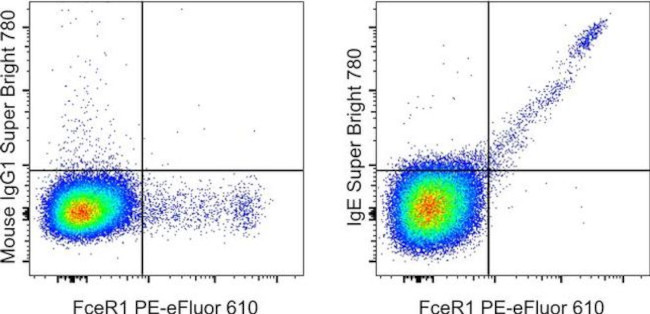Search Thermo Fisher Scientific
Invitrogen
IgE Monoclonal Antibody (Ige21), Super Bright™ 780, eBioscience™
FIGURE: 1 / 1
IgE Antibody (78-6986-42) in Flow

Product Details
78-6986-42
Species Reactivity
Host/Isotype
Recommended Isotype Control
Class
Type
Clone
Conjugate
Excitation/Emission Max
Form
Concentration
Purification
Storage buffer
Contains
Storage conditions
Shipping conditions
RRID
Product Specific Information
Description: The monoclonal antibody IgE21 recognizes the immunoglobulin E class of antibodies. The natural levels of IgE in the serum are quite low, comprising only a small portion of the total immunoglobulin. IgE plays a role in allergy responses by binding to mast cells and basophils through the Fc epsilon receptor I which results in the release of histamine and other molecules. The IgE is produced by terminally differentiated plasma B cells and basophils. Like all immunoglobulins, IgE is expressed as a soluble molecule as well as a membrane bound form. IgE21 recognizes both forms.
Applications Reported: This Ige21 antibody has been reported for use in flow cytometric analysis.
Applications Tested: This Ige21 antibody has been pre-titrated and tested by flow cytometric analysis of human peripheral blood cells. This can be used at 5 µL (0.25 µg) per test. A test is defined as the amount (µg) of antibody that will stain a cell sample in a final volume of 100 µL. Cell number should be determined empirically but can range from 10^5 to 10^8 cells/test.
Super Bright 780 is a tandem dye that can be excited with the violet laser line (405 nm) and emits at 780 nm. We recommend using a 780/60 bandpass filter. Please make sure that your instrument is capable of detecting this fluorochrome.
When using two or more Super Bright dye-conjugated antibodies in a staining panel, it is recommended to use Super Bright Complete Staining Buffer (Product # SB-4401) to minimize any non-specific polymer interactions. Please refer to the datasheet for Super Bright Staining Buffer for more information.
In some experiments, we have observed that compensation values for Super Bright 780-conjugated antibodies are higher in the violet 450/50 channel when using UltraComp eBeads microspheres (Product # 01-2222-42) as compared to single-color stained cells. In such circumstances, we would recommend setting compensation with cells. We have also observed this in some experiments using AbC Total Antibody Compensation beads (Product # A10497).
Light sensitivity: This tandem dye is sensitive to photo-induced oxidation. Please protect this vial and stained samples from light.
Fixation: Samples can be stored in IC Fixation Buffer (Product # 00-8222) (100 µL of cell sample + 100 µL of IC Fixation Buffer) or 1-step Fix/Lyse Solution (Product # 00-5333) for up to 3 days in the dark at 4°C with minimal impact on brightness and FRET efficiency/compensation. Some generalizations regarding fluorophore performance after fixation can be made, but clone specific performance should be determined empirically.
Excitation: 405 nm; Emission: 780 nm; Laser: Violet Laser
Super Bright Polymer Dyes are sold under license from Becton, Dickinson and Company.
Target Information
IgE is one of the five classes of immunoglobulins found in mammals. Monomers consist of two heavy (epsilon) chains with 4 Ig-like constant domains, and two light chains. IgE plays an essential role in type I hypersensitivity (allergic responses such as hay fever, asthma, hives, anaphylatic shock) by binding to Fc receptors on basophils and mast cells. Crosslinking of IgE bound to Fc receptors induces degranulation of mast cells and basophils that promote allergic manifestations. IgE is also functionally important for immunity against parasites.
For Research Use Only. Not for use in diagnostic procedures. Not for resale without express authorization.
How to use the Panel Builder
Watch the video to learn how to use the Invitrogen Flow Cytometry Panel Builder to build your next flow cytometry panel in 5 easy steps.
References (0)
Bioinformatics
Protein Aliases: Immunoglobulin E; ImmunoglobulinE

Performance Guarantee
If an Invitrogen™ antibody doesn't perform as described on our website or datasheet,we'll replace the product at no cost to you, or provide you with a credit for a future purchase.*
Learn more
We're here to help
Get expert recommendations for common problems or connect directly with an on staff expert for technical assistance related to applications, equipment and general product use.
Contact tech support

